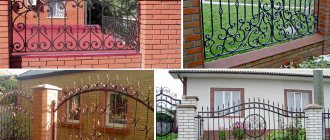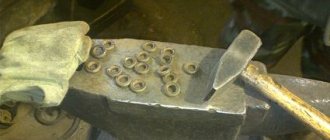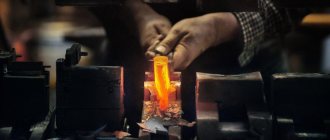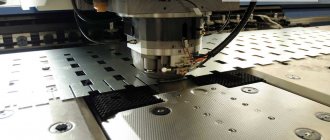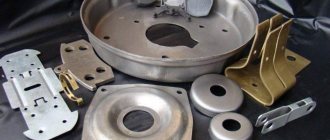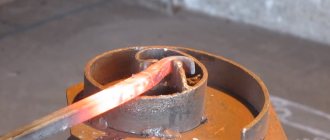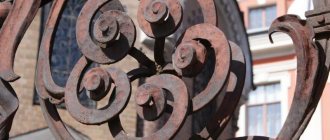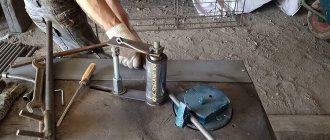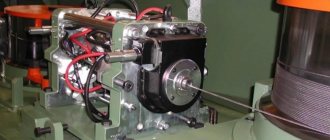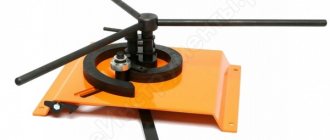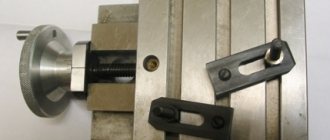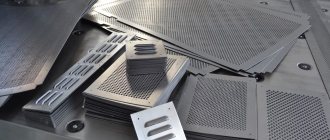Looking at the fences, gates and gates, as in the figure, in houses that are clearly not of the elite class, a person who has some idea about the equipment of the forge and the nature of the work there may think: where did they get so much money? Those more knowledgeable in blacksmithing will not have such a question: these beauties, as well as the metal decor of furniture, light garden buildings, swings, benches, etc., are created by cold forging.
Samples of artistic cold forging
Forged flower stand
Prices for cold art forging are affordable because production costs and initial equipment costs are low, and labor productivity is not bad for artisanal conditions. Consequently, an individual blacksmith specializing in artistic cold forging can count on a fairly quick start and good profitability. Perhaps one of the owners of the samples in Fig. I made my own: cold forging with your own hands can be done in a garage or barn without experience, and forged parts for small pieces of furniture, balusters, barbecues and all sorts of other metal utensils (see, for example, the figure on the right) can be done even at home conditions.
The basis of a “cold forge” is a cold forging machine. For a full production cycle, capable of satisfying any conceivable fantasies of your own or the customer, you will need 5-7 types of machines, 3-5 main ones of which you can make yourself. However, in the beginning, before spending money on a machine or materials for it, it is highly advisable to master the basics of blacksmithing. Therefore, further we will also consider some techniques for making artistic forging parts without a machine and equipment for them, which can be quickly made from scrap materials.
Do-it-yourself cold forging as a separate art form
Cold forging is a method of forming metal products under pressure. This method consists in the fact that the metal is not heated before deformation, but is bent using special machines. Forged patterns will decorate garden fences, stair railings, windows or entrance doors. Simplicity and low cost will allow anyone to quickly master the process and independently bring their ideas to life.
Using the cold forging method you can create incredibly beautiful products.
Video: homemade electric cold forging machine
Spiral like a spiral
Device for winding spirals manually
In some cases, ordinary smooth, straight, ascending spirals are used as an element of artistic forging. Making a spring twister machine for this on your own is absolutely unrealistic. But remember: the spirals in a forged pattern do not need to be springy and can be wound from ordinary ductile steel using a simple device (see figure on the right). The pitch (ascent) of the spiral is determined by the horn of the gate (filled in red); By bending the horn up and down, you can get thinner and thicker spirals. A square bar is taken onto the workpiece or a round one, it doesn’t matter. You can also twist spirals from a rod twisted on a torsion bar.
History of the forge: description of cold forging
Forging is a process of processing metal to give it the desired shape, turning a blank (blank) into a product. For people who are unfamiliar with the peculiarities of metal work, the word “forged” is associated with a forge, where a blank is heated from 800 to 1000 ° C and processed with a hammer to give shape. But in everyday life, items made by cold forging are more often used. Pots, teapots, patterns on gates and doors, metal stands are made by deforming metal under pressure without preheating.
Beautiful forged elements can be created even at home without the presence of special expensive equipment.
Cold forging is an easier, safer and more ergonomic processing method than hot forging. Main advantages:
- equipment for cold metal forging is cheap and ergonomic;
- low labor intensity;
- quick job training, low qualification requirements;
- the ability to create a unique ornament from basic elements.
The downside is the limited working surfaces and materials: rods, sheets and plates.
Cold forging is one of the ancient methods of metal processing.
Hand-made cold forging is historically older than hot forging. The first products were discovered in Egypt and Mesopotamia and date back to the 4th-3rd millennium BC. Initially, ore was used, which was deformable after being hit by a stone. Cold forging was used to make gold jewelry. Soft metal was easy to process with stone hammers. The oldest product was found in Egypt, it was made 8 thousand years ago.
Several centuries later, by observing volcanoes, people learned that high temperatures made it much easier to shape metals. They began to build blast furnaces and the profession of a blacksmith appeared. The Stone Age gave way to the Iron Age, and not only jewelry, but also dishes, weapons, and garden tools entered people’s lives. The principle of operation of the forge is still preserved, but the equipment for cold forging has been modernized.
Using modern equipment it is possible to create products with a large number of forged elements.
Classification of machines
Types of machines for cold forging.
Cold forging machines are divided into four main types:
- Twisters or snails twist spirals with a flat surface and narrow cores, these machines are most often used for hand cold forging.
- Torsion types of devices are designed for the manufacture of twisted volumetric spirals.
- Bending types - for spirals with wide cores.
- Inertia-stamping - for decorative clamps and processing the ends of all elements.
Before a detailed description of each type, we will go through cold forging technologies, there are only three of them:
- Drawing : This is the rolling out and lengthening of a metal piece, a process similar to rolling out dough with a rolling pin. In forging, pressing rollers work in this way. Using this technology, paws, clamps, and peaks are prepared.
- Torsion : twisting a part along an axis, see below for a detailed description.
- Bending : bending metal according to patterns in different directions.
Basic tools for cold forging at home
The creation of a unique product always begins with material calculations and the development of a detailed work plan. The easiest way to think through the moves is to create scale sketches of forged products, write down the dimensions and select the necessary tools. The choice of material deserves special attention. The metal should be strong, but bend easily.
Note! Hardened sheets or rods cannot be used. Under the influence of temperature changes, the structure of the metal changes, it becomes brittle and can break under pressure.
There are two types of do-it-yourself metal forging - rolling (working with rods) and stamping (extruding sheets under a press). At home, the first option is more often used. To press sheets, you need to make a special blank for deformation. Common rolling tools: bender, snail, twister, wave and flashlight.
Cold forged elements can be used to decorate stairs.
A bender is a basic tool used for bending rods at different angles. The spiral elements of cold forging are twisted using a snail. For shaping, it is best to choose rods with a diameter of 10-12 mm. Choosing a material that is too thick can significantly complicate the work of the master.
A twister machine is used to twist rods along the longitudinal axis. The wave, accordingly, is intended to create wave-like elements. The flashlight tool is used to work with several rods at once. They are installed on the equipment and bent by rotating the lever.
Main stages of cold forging
- Initially, a sketch of the future product is created in exact size. This will allow you to find out the right amount of necessary raw materials and will guarantee proper assembly. And also in order to configure the equipment using a certain method.
- The next step will be to accurately calculate the required volume of material. For example, if you are going to cold forge a flower stand, then you will need an iron pipe, d=15 x 15 mm and 10 metal strips, d=4 x 20 mm, any body for the base. Let it be a simple vase.
- Now you can start making parts. What they are will be up to you to decide, and their design will depend on the equipment on which the processing will be carried out. A drawing of a snail for cold forging will allow you to avoid mistakes and help you complete the work for the first time. Absolutely all 6 types of equipment can be used for just one product, making it more noble or pretentious.
- Next, we weld all the parts of our stand to one pipe, which will be the basis for the structure. Do not overdo it with the welding process if you do not yet fully master it, since when fastening smaller parts you can create extra holes in them.
- The final step will be grinding the weld seam and painting the almost finished product.
Tool + golden hands = miracles
Forging, no matter what it is, has always been considered an original Russian occupation for real men. Therefore, this can become for you not only a hobby, but also a kind of image that will always remain at its best. By making products for yourself, you can save a lot of money and bring more beauty and comfort to your home. Forging for a business purpose will help you achieve the desired result, and the work process will only bring pleasure.
Equipment for rolling at home
You can buy devices for cold forging yourself or make them yourself from available materials. Initially, you need to create 2-3 basic workbenches to process one rod. The design and complexity of manufacturing depend on the type of work performed. A thorough study of the process will allow you to make the equipment yourself.
To create complex forged products you will need more than one workbench.
Inertial stamping machines
This type of equipment resembles presses or pressing rollers, which are sometimes neglected by young craftsmen. But in vain: without shaped clamps for connecting parts and decorated rod tips, the work will never have an aesthetic appearance. These presses work like a flywheel in which the firing pin hits the die area. Decorative parts are small, the accuracy of their manufacture must be very high, so you don’t even need to try to make this type of machine with your own hands.
Everything would be fine, but inertial stamping presses are an expensive pleasure. But here you can find a solution, let's call it an “integrated forging solution.” Various types of tips are very easy to make using hot forging. You don't have to be an experienced craftsman to do this. Either go to a hot forging workshop or start an elegant forge yourself - you can easily and inexpensively make it from scrap materials. For such small work, you don’t need your own separate forge; there’s nothing to do – just heat up the metal.
Gnutik: what products can be created with its help
It is not necessary to create bending drawings for cold forging yourself. It is enough to look at the principle of operation once to make the tool yourself. The machine is a steel tooling, which is divided into three parts. The middle element (lead) is movable; a central roller (wedge) is attached to it, which bends the rod. On the side plates, the rollers are made replaceable and inserted into the groove. By choosing different diameters, you can vary the bending angle of the rod or plate. A lever is attached to the top of the leash, which sets the structure in motion.
On a note! Bending a rod requires a lot of force, so attaching the workbench to a movable support will lead to incorrect bending and make work difficult.
The rollers should rotate freely in the holes, which will reduce the force required to bend the plate. Grooves for the rollers can be drilled in several places symmetrically to each other. This will allow you to quickly move the parts, varying the desired bending angle.
The bender helps bend metal rods at any angle.
Mechanism for bending metal with a bend:
- a plate or rod is installed between the rollers;
- using a vice, the central roller is pressed against the metal;
- By rotating the lever, the plate moves along the roller, acquiring the desired bend.
For convenience, a dial (a tape with divisions showing the height of the angle) is placed under the central roller. It is used to produce parts with high precision that must fit together perfectly.
The bent rolling tool is quite easy to use.
Back
- A conductor is made from a 40x4 strip, 50 cm long, which allows you to create curls, volutes and spirals with reverse curl.
- The strip is bent using a backing fork fixed in a vice, as well as a manual fork. Thus, a spiral is obtained, part of which is removed with a grinder.
- The resulting part is welded to a small sheet of metal.
- A square rod is heated, the tip is processed, and a curl is obtained. The workpiece is given a reverse bend using a hand-made pattern.
Snail: a simple tool for creating curls
The second name is a do-it-yourself conductor for cold forging. For manufacturing, you need to familiarize yourself with the bending process, for example, watch a forging video. Then the design itself will not raise questions and will be easy to repeat. The workbench is a frame on which the main matrix or spiral module stands. A rod is driven into the snail and moved around with a metal roller, pressing against the arc. The frame must be made of metal, since wood quickly collapses after prolonged stress. A metal corner, thick-walled pipe or channel are suitable for this purpose.
The machine is designed for two tabletops. One serves as a support and takes on most of the pressure, and the second holds the shape of the snail. Two circles with a thickness of at least 5 mm are cut out. The first part is installed on the frame. The center of the circle is marked on top, and a three- or four-leaf leg is welded to distribute the load.
The upper part of the volute, on which the metal is bent, is called a module. It can be static or typesetting.
The snail tool allows you to create curls from forged metal.
A static module is a device for cold forging, designed for bending pattern parts of the same type. The bend radius or angle cannot be changed. Before starting to form the module, markings are drawn on the tabletop. A snail is assembled from metal plates (at least 0.6 mm thick) and welded.
The typesetting module consists of several parts. Its use is the most common for do-it-yourself artistic forging, as it allows you to create elements of different radii. Initially, parts are marked on the tabletop and the grooves are calculated. Removable parts of the snail are cut out of thick metal. Holes for fixing to the tabletop need to be cut only in the middle. Otherwise, the stress is distributed unevenly and the groove breaks faster.
The module for forging with your own hands can be made replaceable. A structure of the required radius is welded onto a metal circle. It is attached to the tabletop with grooves or bolts. To produce elements of different diameters, several modules are made that can be used on one machine.
The typesetting module will allow you to create curls of various radii from forged metal.
A rotating shaft and lever need to be secured between the tabletops. It is necessary that the distance between the roller and the module be at least 2 cm, and the shaft stroke must extend beyond the tabletop. A movable element is installed on the lever handle to adjust the radius of the roller stroke.
Summary like clockwork
Types of stamps and ready-made curls.
A good story is always easy to finish - the conclusions fall on their own, within the framework of logic and priorities.
In our review of cold forging technology, the harmonious conclusions are clear:
- Cold forging is a wonderful technology that allows you to combine what is impossible to combine in other processes:
- practical benefits on the farm;
- the possibility of artistic creativity;
- invention and application of own engineering discoveries;
- simplicity and reality of implementation for beginners;
- increasing self-esteem as a craftsman and as a resident of a house with elements of artistic forging.
- You can make devices for cold forging yourself and with high quality, it is better to start with snail and bending machines.
- It is more expedient to make manual equipment with a manual drive. The electric use case is too resource intensive. The only type of machine that is best made with an electric drive is a torsion bar one. The quality of twisting the rods will be much higher in this case.
- In the manufacture of forged products using the cold method, “help” from hot forging will not hurt. It is impossible to make a machine for tips and other small decorative elements on your own, but a purchased one costs a lot of money. Our advice is to make decorative details using hot forging. A small and neat forge in the household will not hurt. And it will contribute to professional growth: start with cold forging, come to real blacksmithing...
- You shouldn’t get stuck in the stereotypical “antique” painting of forged items. Modern colors and widespread eclecticism in design make possible the most unexpected color and texture solutions in metal work.
https://www.youtube.com/watch?v=bJWuvMMy1H0
Wave: how to create and use this tool
Wave is a tool for forging lines like a sine wave. Two rollers are machined to the specified dimensions. The first roller is static (the rod will bend around it), it is fixed on a support. The second is the leading one, it is mounted on a lever and rotates when it comes into contact with the surface. Pressure is generated between the shafts, which acts on the metal and causes it to bend.
The static roller can be machined into the shape of a stepped pyramid. Thus, the radius of the wave can be changed by moving the lever and rod higher by a division. When using such a machine, one side must always be held in order to avoid damaging the bend. To more accurately repeat the wave shape, two static rollers are machined, one of which holds the rod in the desired position, preventing further deformation, and the second is used for bending.
The “Wave” tool will help you make the rod wavy.
Technologies used for metal processing: the difference between cold and hot forging
Cold forging, unlike the hot method, does not involve exposure to high temperatures on the metal, so the workpieces do not change their chemical characteristics when deformed. The processing technology is based on the physical property of the material - plasticity. Thanks to the latter, non-ferrous and ferrous metals, which include aluminum, bronze, copper and steel, can withstand significant tensile, bending and tensile loads. As a result, the material can be processed without heating in many ways using special machines.
In the process of creating products, the metal is pressed, due to which its structure is compacted. Bending rods, strips and pipes also increases the strength of the material. After deformation, no residual stress appears in the finished elements, which could contribute to their destruction. For this reason, there is no need to carry out additional operations such as tempering, annealing and hardening, which are performed during hot forging. In addition to non-ferrous metals, low-carbon steels of grades 3, 20, 25 are well suited for cold deformation.
Flashlight and twister: features of these machines
A flashlight is a cold forging equipment for working with several rods and creating three-dimensional baskets. To avoid constructing a frame, you can use a regular vice to secure the tool. The tool consists of three parts: two dies and a roller. The matrix can be made of strong, preferably hardened metal 4-5 cm wide.
In each matrix, a central hole is machined into which the roller is mounted. Grooves are made on the sides for installing rods. The second matrix must move freely along the lever, since during deformation the distance between the working surfaces decreases. When the lever is rotated, the rods bend in a spiral, forming a structure similar to a flashlight. Do-it-yourself metal products, which consist of several rods, are secured by welding.
The twister machine has a similar design. However, instead of a shaft, a rod is inserted into the matrix, which is pressed with a plate or bolts. Between them you need to install a movable element that moves forward when the shaft rotates. The rod twists along the longitudinal axis, forming a symmetrical spiral.
You can create forged elements using the flashlight and twister tools.
Note! The running matrix should approach static with each rotation. If it is fixed in one position, the master will have to make more efforts to bend the rods.
Connecting parts and painting
Now all the curls need to be collected into a single canvas. The work is not easy, but very rewarding: it is at this stage that the main artistic idea begins to be realized. Meanwhile, at this stage you can easily ruin everything. This is easy to do: start connecting the parts by welding, and then use a grinder to clean them.
But we have already talked about the professional ambition of cold forging masters, which can only be welcomed. Special U-shaped clamps, which are stamped on inertial machines, will look much more impressive. Don’t be lazy, but work well with the clamps - this is the key to successfully completing the forging of the product.
Torsion of metal on a machine.
Now about painting. Thank God, now there is something to paint: thanks to modern construction technologies, there are a huge number of paints on sale for every taste, budget and, most importantly, purpose. There are countless paints for metals. Most often, special acrylic paints for metal or blacksmith's enamels are used.
Very often, for completely unknown reasons, blacksmiths prefer a finish coat with paint with pigment from a forge patina - “antique”, showing an amazing unanimity in tastes. If you are a forging customer, then you need to stop the craftsman in time to offer him your own version of the color and texture of the coating. But seriously, who said that forging should be dark and antique? And the white one? Colored? This is where there is vast space for the most daring artistic solutions.
Do-it-yourself cold forging under pressure: creating blanks for forming products
On wrought-iron fences you can often notice not only geometric patterns, but also flowers, butterflies, leaves and other decorative elements. They are also made using cold forging techniques, but by rolling rather than stamping.
Do-it-yourself volumetric forged products are made from sheet metal. Working with a press at home is less common than rolling. Extrusion of sheets under a press can be either manual (knocking and pressing) or automatic. At home, it is cheaper to use hand stamping. To do this, the master needs to make several blanks that will be printed on a metal sheet under pressure.
A drawing of the future forged product will greatly facilitate the work of the craftsman.
Metal forging equipment:
- Punch (press stamp or cotter pin) is the upper part of the press, it pushes the sheet inward. The pressing side of the stamp can be drawing or smooth.
- Matrix is an element that is made in the shape of the required object. The applied relief deforms the plate under pressure, giving it the required shape.
- Press lever - a handle or relay for bringing the dies closer together and adjusting the force of the press.
Before starting work, you need to create a drawing of the future product. Sketches of artistic forging are transferred to the workpiece, it is cut and ground along the edges. You can use a regular vice as a workbench for pressing. It is most convenient to place them in a vertical position so that the plate lies horizontally to the plane. This way, the plate will be positioned exactly between the dies and will not slip out when the lever is rotated.
Different types of workbenches allow you to create unique forged elements.
Simple forging of metal at home can be done with a chisel and hammer. In this case, the chisel acts as a punch, the anvil as a matrix, and the hammer as a lever. To better print the design, you can put a plate with notches under the sheet. This way the relief will be clearer and more beautiful.
Note! The metal used for stamping must be softer than the punch and die. Otherwise, the tools will quickly break.
To make the “sheet” element, a blank of the desired shape is cut out of a metal plate 20-30 mm thick. A longitudinal line is drawn on it with a pencil in the center. The chisel striker is placed at an angle to this straight line. After hitting the handle, a line is imprinted on the plate, similar to the veins of leaves.
The cold forging method can be used to create three-dimensional elements.
You can use pliers to form the required volume of a cold forged product. The part is clamped between a vice and bent into the desired shape. This type of work is well suited for completing a small number of items for personal use. The process of beating a pattern by hand takes a lot of time, it is quite monotonous and requires great precision.
It is more profitable to purchase stamps for permanent work (in the form of leaves, petals, flowers, etc.), since accurately turning two identical elements is a very complex process. The main parts are machined from a blank or cast by hot forging. This type of work requires a lot of experience and high precision. The punch and die must match. With strong pressure, irregularities will be imprinted on the product. If the discrepancy is very large, then the press will crush the workpieces - and you will have to start work from scratch.
Torsion bars
Torsion twisting of a rod without a machine
You can twist rods with a screw for artistic forging without a machine at all, see fig. on right. To prevent the workpiece from bending at the root (clamped in a vice) end, you need to place a wooden block or something like it with a V-shaped cutout at the top under the end of the guide pipe farthest from them; It is better to secure the pipe to this support with a clamp, and secure the stand to the workbench. The pipe should be shorter than the workpiece and approximately 1.5 times wider inside than its largest diameter, because When twisted, the workpiece contracts and expands in width.
A torsion cold forging machine allows you to increase productivity and improve the quality of the resulting parts. The working force in it is transferred to the support to a significant extent, so a strong frame is needed, in the form of a spinal frame made of an I-beam from 100 mm or a pair of welded channels of the same size; the corrugated pipe will apparently be deformed. The frame must be securely secured to the supporting surface using paws from the same profile welded to its ends, pos. 1 in Fig.
Homemade torsion bar machines for cold forging
The workpiece - a square rod - is held by mandrels-chucks with sockets also of square cross-section; they are visible there in pos. 1. Because When twisted, the rod shortens in length; the chucks in the spindle and tailstock must be securely fixed with screw clamps. For the same reason, the tailstock is made sliding. To allow twisting of individual sections of the workpiece, a sliding stop with an insert with a square hole is also used.
If you only need to make a fence for yourself or something smaller, you can quickly build a torsion bar machine from scrap and scrap materials, pos. 2. On both machines, in principle, it is possible to obtain filaments by placing a bundle of 4 rods half the size into the cartridges. But don’t think that you can make a good lantern or basket by simply pushing the tailstock with a lever. You will get something like the one in the inset in pos. 1 and 2. Blacksmiths call such incidents a word that is generally known, but not used in literary speech. The branches of the filament, when twisting it in a simple torsion bar machine, must be spread out in width with a hand tool, which is difficult and does not ensure the proper quality of work.
Beautiful filaments (pos. 3) are twisted on torsion bar machines with a fixed tailstock and a screw feed spindle, pos. 4. Now let’s return briefly to Fig. with types of machines at the beginning, to pos. 2 on it. See the thing marked with a green exclamation mark? This is a replacement spindle. There are 2 of them in the set: smooth for spiral twisting along the long axis of the workpiece and screw for twisting filaments. In this design, the frame is welded from a pair of channels with a longitudinal gap, and a shoe with a threaded hole for a locking screw is welded to the tailstock. A shoe is needed with a sole from 100x100, because The tailstock fixation in filament mode is frictional and only partially jammed: the locking screw provides only an initial clamping force.
About the electric torsion bar drive
Electric drive of a homemade torsion bar machine
Working on a torsion bar machine with a manual spindle drive is tedious. But the main thing is stable quality of products such as in pos. 3 fig. with torsion bar machines, it is even more difficult to achieve. The reason is that it is difficult to create a uniform torque in a circle with your hands, like with any other lever drive. Therefore, a torsion bar machine for cold forging is exactly the case when the use of an electric drive is justified no matter what. The best option from available materials is the axle shaft of the drive axle of a rear-wheel drive car with a gear pair from the differential from the same place, see fig. on right; Just don't forget about the protective casing! Motor - 1.5-3 kW and no more than 900 rpm. Other design options are also possible, see eg. video clip:
Styles and elements of patterns: photos of artistic forging
Creating a beautiful pattern begins with a forging sketch. The master must have a clear idea of the picture he wants to make. Initially, a drawing is drawn, materials and the number of necessary elements are calculated, machines and equipment are selected. In order for the product to look beautiful, it is better to immediately choose the style in which it will be made. Looking through photos of cold forged products, you can easily notice which direction the pattern belongs to.
Beautiful forged products can be made in various styles.
There are several styles of forming a forged pattern.
The Romanesque style is characterized by severity and symmetry. On the fences you can see a dense arrangement of spirals in the same order, the details are often repeated and of the same type. This is a monumental pattern using the volute element (C-shaped twisted one-sided curls).
Gothic ornament . Few people know that modern fencing and fences are most often made in this style. A characteristic feature is upward striving. The rods are pointed and end with tops in the form of arrows, spears or sharp spikes. The spiral elements used in this style are called perforations, and they look like a stem branched in different directions. For variety, lanterns or voluminous spirals are added between the straight rods.
Products in the Baroque style are the most common.
Renaissance is very rare. In this style, pointed charcoal elements are practically not used. The basis is round arcs, spirals and waves. The branching metal rods are decorated with leaves or flowers; graceful curves take the shape of a figure eight. Characteristic elements are notch, spiral, volute and figure eight. The style is very harmonious, the details are installed symmetrically in the form of intertwined lines.
Baroque is the complete opposite of Renaissance. The style is openwork and very lush. C-shaped spirals, volutes, curls, curved lines and intricate patterns are used. Three-dimensional leaves and flowers are added to the weaving, creating a dynamic shape.
Rococo . This direction is characterized by the use of thin rods and double-sided curls. The rocaille ornament creates constant movement and is distinguished by filigree and three-dimensional patterns. In the photo of cold forging, asymmetry and fractional patterns are noticeable. The use of straight rods and flat gratings is unacceptable.
The classic style allows you to combine various forged elements.
Classicism . A beautiful, albeit simple style that brought symmetry back into fashion. To create an ornament, curls, perforations, spirals and straight rods are used. Another element is introduced into use - a meander (broken lines or rods bent at right angles). Vertical architectonics are always strictly maintained in fences.
Empire style is characterized by the presence of geometric patterns and long smooth rods. The main element (volute) is modified: an elongated straight line with one-sided curls at the ends. The main thing for this style is strict simplicity, symmetrical geometry combined with spiral elements.
Art Nouveau , or Art Nouveau , added biological motifs to artistic forging with one's own hands. The style does not use straight lines, only various bends, meanders, curls and spirals. Symmetry fades into the background. The ornament repeats the silhouette of a person or animal, leaves and flowers are added. The pattern is constructed in such a way that the curls evenly flow into each other throughout the entire ornament.
It is difficult to create a beautiful forged pattern without a drawing.
If a person starts work without a preliminary drawing, he will quickly get confused in creating a cold forged product. Each pattern should be thought out as much as possible, and it is better to immediately transfer edits that are made during work to the sketch in order to clearly understand what the result should be.
On a note! Even if you have photos of forged patterns, you need to make drawings and markings to accurately place all the parts.
Why is cold forging used and what products are produced?
Using hot forging, you can forge a product of almost any shape - from a ship anchor and a cart axle to a metal rose and a grape vine.
Cold forging is used to produce a limited number of elements from which a talented designer can assemble a custom product.
Forged rose bottle stand
Forged fence roses
Forged Products
A wide variety of products are made using the cold forging method. These are, first of all, elements of gratings and fences - both the rods themselves and the crossbars, tops, and decorations. From a distance of several meters it is difficult to distinguish it from a forged lattice. Any lattice will be enlivened by curls and spirals that form intricate patterns and ornaments. An ordinary fence, therefore, in addition to its utilitarian purpose, also acquires artistic value. For this you will need a bend, a snail and a torsion bar.
Wrought iron bench with table and lamp posts woven with vines
Forged stands for lanterns, railings for bridges over ponds, awnings and porches, tables and benches look great in the local area. And it’s a good idea to make the gazebo itself from a forged rod. Curls and spirals will give it unexpected lightness and airiness for harsh metal, and twisted supports will emphasize the upward desire.
Forged barbecues are also widespread today, also complementing the economic purpose with an aesthetic impression. The barbecue itself is lost among the canopy, patterned walls and supports, and the roof decorated with curls.
Parts of balustrades, staircase railings and balconies are also very popular. Curls and spirals are also widely used here, not only as decoration, but also as a structural element. A baluster twisted along the longitudinal axis looks very appropriate, and corner supports are often made from several rods twisted together. They also make the so-called on a torsion bar machine. “flashlight” - several rods bent in a spiral, connected at the ends by welding.
Fascinating forged door handle
Country style wrought iron wall hanger at the entrance
Exclusive forged door bolts
The next area of application of cold forging is details of room decoration and furniture. Door handles and latches, fireplace tools and hangers, umbrella stands and cornices for curtains and curtains - small curls and twisted rods are widely used here. Furniture is made both for garden furniture, which is not afraid of precipitation and changing seasons, and for home furniture, combining metal with wood and fabric.
Fastening the pattern elements: final metal processing
After all the necessary elements of the ornament have been created, its formation begins. The appearance of the pattern may differ slightly from the sketch. To identify possible errors, you need to conduct a preview. Initially, the pattern can be laid out on a flat surface without fastening its parts together. In this way, you can evaluate how successful you were in bringing your idea to life, as well as correct shortcomings in your work. You should not start forming a pattern without first viewing the result.
Products look more complete if the elements are connected by welding.
There are two main types of connections:
- Weld;
- rivets (or artistic clamps).
It is useful to use a welding machine in places where the joint seam can be easily cleaned or will be invisible. To preserve the aesthetics of the ornament of a cold forged product, you can put figured rivets. They will reliably hold the components together and complement the decor.
The ornament is connected gradually, depending on the number of parts. Initially, small elements are held together, notches, twisted lines and monograms are formed. Welding is used. The seam is smoothed with a grinder using a 0.6 cm thick sanding wheel. It easily goes around bends and irregularities. Large parts are connected with curly clamps. The rivets are placed symmetrically to each other to complement the pattern. At the end of the work, the ornament is passed around with a cleaning or polishing wheel.
Cold forging allows you to create beautiful and original products with your own hands.
Artistic forging is not only a business or a job, but can also be an entertaining hobby. Even a novice craftsman can make cold forging equipment with his own hands from scrap materials. Cold forging specialists can easily be called artists, as they create beautiful ornaments from rough rods, pipes and sheets. Such hobbies require full dedication and considerable expenses. However, all the invested funds and efforts will bear fruit if they are supported by the desire to create beauty.
Snails
The snail twister machine is the most popular among those involved in artistic forging: its capabilities, in comparison with the simplicity of the design, the ease of making it yourself and the ease of operation, are amazing. Actually, the snail machine is a slightly mechanized and improved bending lever, but this “little” made it possible for beginners to work on it. Snail machines are, in turn, divided into machines with a collar and a rotating plowshare and lever machines with a fixed template and a deflection roller.
Snail with ploughshare
The device of a bending scroll with a plowshare is shown in the diagram below; The technology for working with such a machine is also described there.
Schematic diagram of a snail machine for cold forging
The advantages of this type of twister bending machine are as follows:
- It is possible to work on a scroll with a rotating share and a collar in an unequipped room: the vertical component of the workload is negligible, and its horizontal components are partially transferred to the support.
- Due to previous point, the supporting structure can be quite simple and light, welded from ordinary steel profiles.
- We can carry out the work process alone: turning the gate with one hand, we press the rod or strip against the template plowshare with the other. As its links bend, they will fall into place on their own.
- Using a cold method, you can twist spirals of up to 5 turns on a snail with a rotary plowshare.
Drawings of a snail machine for artistic forging with a specification of parts are given in Fig. We’ll talk about the dimensions of the links (segments) of the folding share later, but for now pay attention to the steel grades: the share bears heavy loads. If you make it from ordinary structural steel, the template will lead to the middle of the gate or fence section.
Drawings of a snail machine for cold forging
Note: for more detailed drawings of a snail machine of a similar design with description and detail, see the link: https://dwg.ucoz.net/publ/osnastka/instrument_dlja_kholodnoj_kovki/5. There you will also find drawings of a homemade bender and a device for bending rings.
The material for the folding rotary share, as well as the complexity of its manufacture, are not the only weak points of the snail machine with a collar. An even more serious problem is the articulation of the ploughshare links (shown by red arrows in the figure on the right). The joints of the share segments must:
Design of folding ploughshare of snail cold forging machineBe accurate enough to maintain the shape of the manufactured parts;
- When pressed from the outside, the joints of the segments should become dead center, creating a stable configuration;
- Upon removal of the working load, the joints should self-weed;
- The design and material of the joints of the rotary share must ensure repeated repetition of the cycle according to paragraphs. 1-3 under significant alternating operating loads without the appearance of significant backlash.
It is difficult to fulfill all these conditions together in a well-established and equipped industrial production, so the resources of folding templates for cold forging are generally much less than their material would allow on its own. Poor use of material properties is a serious drawback. In addition, for the same reasons, another weak point of the snail-type machine with a collar is the eccentric clamp of the part. Therefore, novice homemade blacksmiths work more successfully with homemade snail machines for artistic forging, made according to a lever design.
Snail with lever
The lever volute for cold forging is designed similarly to the well-known pipe bender. A homemade lever-type snail machine with a fixed template is significantly inferior in performance to a snail with a collar. The working load in it is more fully transferred to the base, so a strong frame made of special steel or a thick plate of ordinary steel, securely fixed to the supporting surface, is required. As a result, a workshop or outdoor production area is required. Work on the lever scroll progresses slowly: after turning the lever until it jams, you need to move the pressure roller. It is possible to curl up to 3-4 turns on a lever volute. Nevertheless, the advantages of a snail lever machine for home craftsmen are significant, especially when working for yourself:
- All parts, except the pressure roller, can be made of ordinary steel.
- It is possible to use a standard roller bearing as a pressure roller.
- The use of the material properties of the parts is almost complete: the template and frame made of ordinary steel can withstand more than 1000 working cycles.
- You can bend either according to a template (pos. 1 in the figure below) or using spacers, pos. 2 there.
Snail cold forging machines
- When bending along spacers, you can quickly change the shape of the resulting part and create reverse bends, which is basically impossible when bending along a plowshare.
- Securing the end of the workpiece in a cold forging machine
To obtain products of the same quality, the manufacturing accuracy of parts of a lever volute can be an order of magnitude lower than that of volutes with a rotary share.
- The end of the workpiece can be secured by simply inserting it into the recess of the template, see fig. on right. The end to be fixed is widened by welding or bending in half.
In addition, the snail lever machine allows the use of a technological technique that is considered the prerogative of industrial twister machines: the template is shifted to the side, and a spacer is placed in the center, pos. 3 in Fig. This creates a small reverse bend in the core of the curl. The part looks more impressive and, when working for sale, the product is more valuable.
Flat bending of steel strip
The lever snail has another rather fat plus: on such a machine you can bend flat curls with a small core from a strip laid flat. The snail with a collar and a rotating plowshare gives up completely here: the workpiece will go in a vertical wave. Wide curls and rings from the strip can be bent flat on a broaching machine with rollers in which grooves are machined, see fig. on right. But the drawing speed, so that the workpiece does not lead, requires a significant one, so you won’t get a narrow curl core.
On a snail lever machine, this problem is solved by installing a pressure roller with a height equal to the thickness of the strip and with a flange (edge), like a railway wheel, only wider. Bending using this method takes a lot of time: the lever must be applied a little at a time, otherwise the inner edge of the workpiece will wrinkle; The flange does not help from this. But it is impossible to obtain a curl from a flat strip with a narrow core in a handicraft production in any other way.
In general, at the start of blacksmithing and artistic activities or when making a forged fence, gate, gate, bench, swing, gazebo, etc., arranging a garden for yourself, it is still better to use a lever-type snail machine for cold forging. Moreover, it can be made from scrap materials without accurate and detailed drawings, see for example. next video.
How to paint forged products
Forged products can be painted with alkyd, oil, acrylic and nitrocellulose enamels. Each of them has its own pros and cons. Some are more suitable for interior work, others for exterior finishing. In addition to them, there are compositions specially made for painting metal, including forged products.
Hammer paint consists of synthetic resins, silicone, crushed glass, aluminum powder and other components. It is suitable for both internal and external use, it can be applied even to an unprepared rusty surface, during operation it is maximally resistant to any influences, and retains its marketable appearance for about 25 years. Paintwork materials have high aesthetic properties: small potholes form on the dried surface, visually reminiscent of marks from hammer blows.
Forge paint is expensive, but its effectiveness and efficiency exceed the price. The consistency is similar to liquid rubber. High quality and long service life (8 years) of the German forging paint WS-Plast. The WS-Patina composition has a patina effect. Zinga coating protects metal from electrochemical and physical influences and lasts for more than 40 years. All these paints dry no later than 2 hours after application.
Important: It is not recommended to coat cold forged products with nitro paint. It is cheap, but loses its presentation within a year or two after use.
Types of resulting patterns
Many artistic elements are created from bulk hire. Based on drawings or sketches, parts are forged, which are subsequently combined into a composition.
- Spiral. The diameter of the part downwards and upwards can, respectively, decrease or increase with a change in direction. The result is a unique pattern, the final appearance of which depends only on the artistic intent of the master.
- Double-row spiral. The element in the middle has an increased diameter. The ornament is called “Chinese lantern”. This pattern is usually created by cold hammering from thick wire.
- Volute. The coil-shaped pattern has different directions. A volute with a single-vector concavity has one bend axis. In a multidirectional element, the curls are located on both sides relative to the center of the workpiece.
- Cool. The ornament is obtained by twisting a ribbed rod around its axis. The metal is deformed only in one direction, otherwise the workpiece may crack.
- Top. It is a rod with a sharp decorative end. Several curls are fixed to the element. Windows are decorated with structures made from these parts and private areas are blocked.
Artistic cold forging parts are created from rolled sheets. Flat workpieces made of soft non-ferrous metals lend themselves well to processing.
- Spatial spiral. Visually similar to a screw. As it rotates, the part decreases in width. To give the element a relief appearance, artistic notches are made on the edges.
- Flat curl. Reminds me of a volumetric analogue. The element is made by cold forging from a metal strip.
- Coinage. The technique is based on spot processing of rolled sheets. As the latter, blanks made of non-ferrous metal are usually used.
- Rooting. When making a pattern, a special stamp is pressed into the material. This method creates monograms, three-dimensional images, and various inscriptions.
Another option for artistic sheet forging is a head. The bowl-shaped container is obtained by folding the strip. The shape of the element depends on the master's intention.
Important: You need to remember that if a mistake is made when creating a pattern or composition, it will be impossible or very difficult to correct it. In most cases, the element will have to be completely redone.
Differences between cold forging and other metalworking methods
In addition to this method, the following is used for the production of metal products:
- Casting. The alloy is heated to a liquid state and poured into molds.
- Mechanical processing (using a cutting tool). The workpiece is turned, drilled, planed, etc.
- Hot forging and stamping. The workpiece is subjected to impact in a heated state.
Thus, the differences between cold processing and alternative methods are as follows:
- The workpiece is not preheated.
- Its integrity and structure are not violated. The required shape is achieved by cold working under the influence of external force.
